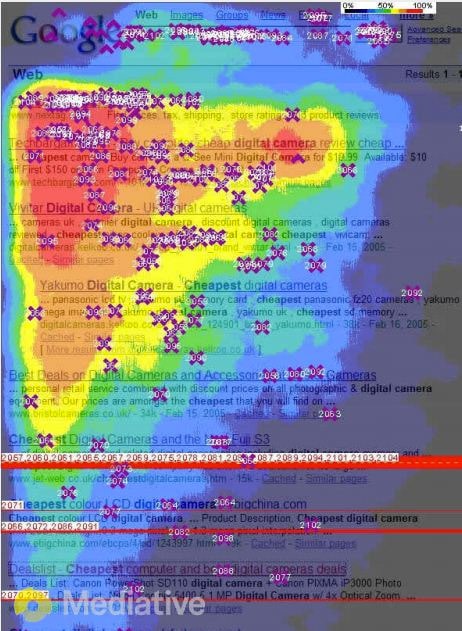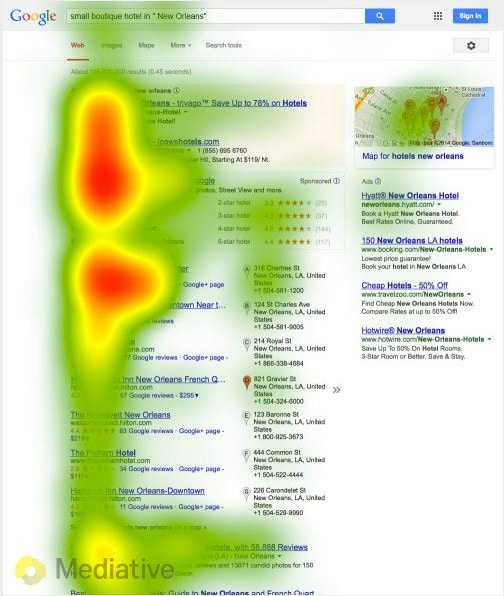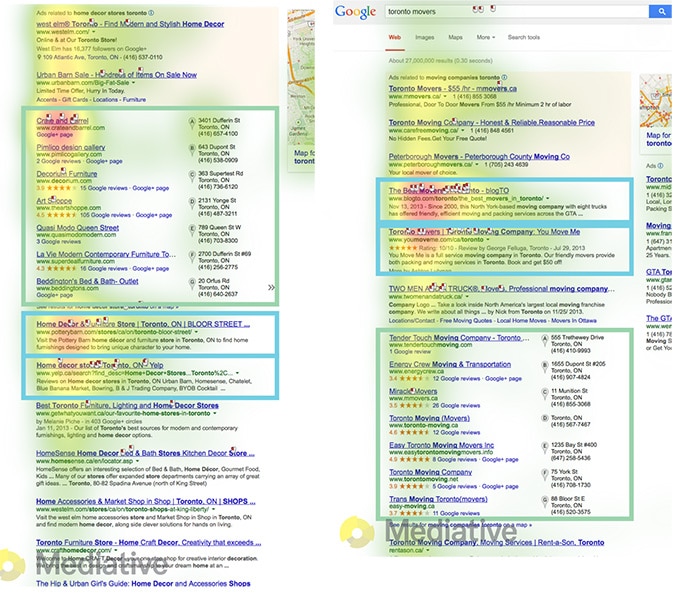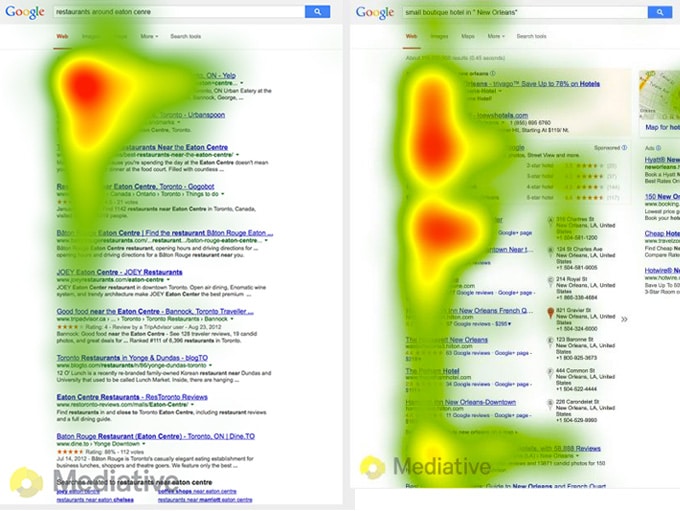Online marketing tactics must constantly evolve in order to anticipate and adapt to increasingly complex search engine algorithms. Google notoriously updates its algorithm regularly in an effort to combat spam and meet searchers' needs. Some changes are major and cause considerable shake-ups in the marketing community, but the majority are minor adjustments that are rarely noticed. According to Moz, Google tweaks its algorithm 500-600 times per year; no firm could be expected to keep up with such transition on a day-to-day basis.
Less regularly but not less significantly, Google also makes modifications to the design of its search results pages. Over the past several years, Google has introduced new page items, including the knowledge graph, carousel, local listing packs and map listings. Ads now look more like organic listings, and site owners have the ability to add visual information to their listings, like star reviews, through schema markup.
These changes in Google's results pages affect how users interact with listings. In addition to working to achieve a good ranking, firms should understand how searchers use the search results page. A new Mediative eye tracking study compares heatmap data from 2005 to new heatmap images generated by its 2014 survey group. The data shows that users scan search results pages in significantly different ways as the pages evolve.
Mediative's study asked several questions, including:
- Where do searchers look most?
- Where do searchers click most?
- Has the increased complexity of Google's results pages affected user behavior?
- How has click activity for each listing changed?
Key Findings: Comparing 2005 to 2014
The Golden Triangle
In 2005, heatmapps revealed the presence of the Golden Triangle — an area of intense interest at the top, left-hand side of the page. People focused on the first two or three results and scanned the page horizontally to read descriptive meta information (the smaller text below the listing title). Few people scrolled to the bottom of the page, and interest dropped sharply after about the third result.

In 2014, study participants displayed a willingness to look beyond the first three results to find the listing they most need. In part, this is a necessary adjustment since Google's results pages are now more complex. Not all of the new elements, like image suggestions or promoted ads, are relevant to every searcher. People may need to look below the scroll to find an organic listing that answers their questions.

Mediative suggests that searchers have been trained to scroll because of increased use of mobile devices. When reading or searching on a phone, a user has to scroll and scan vertically (rather than horizontally) to get information. Changes in design trends and the introduction of the infinite scroll on sites like Pinterest and Facebook also contribute to this new habit. Users are simply more accustomed to the scroll and understand that important information may rest at the bottom of a page.
Interaction with results
Searchers are now clicking on more individual results but are spending less time on each. This change in behavior indicates that people want to look at a wider variety of results than they did in 2005, but they also want to make a decision just as — if not more — quickly. Users spend an average of only 1.17 seconds viewing each listing. A searcher might, for example, click on 11 different listings but will make a choice about which is best based on a very brief scan of each of the pages.
Users are also scanning the search results page more quickly. Current users find it more difficult to predict where the most relevant result will appear on the page. While Google has gotten better over the years at judging which pages contain useful information and which are simply spam, searchers have lost trust in Google's ability to display what they are looking for in the top position on the page.
For some searches, the real estate below the second listing has increased in value. This may be good news for those competing against large, established business and national directories. Depending on the user's intent, he or she may find the best option below the top ranked result.
Effect of local listing packs
For some searches, Google displays a local listing pack within the results page. The listing pack consists of three or seven local results and may appear above or below other organic results. Local listings receive attention and clicks depending on their placement. When the local pack appears above the first organic listing, both the top local listing and the first two organic listings beneath the pack receive significant consideration. When the pack appears below several organic listings, the local results garner far less attention.

Interestingly, when the search results page contains no additions — no images, no local pack, no carousel — the Golden Triangle still exists. But people still scan more quickly and tend not to read as horizontally. Mediative believes that searchers may still be looking for the top organic listing, but interruptions in the results page are distracting, making that result more difficult to find.

Intent of searcher is critical
The top organic listing on any search results page still garners the most clicks (32.8%), regardless of page layout. And the top four organic listings still capture half of the click activity. However, search marketing is not just about being number one. It is also about understanding the needs of your searchers.
When users perform informational searches, they are much more willing to scroll and consider a variety of results than they were in 2005. Consider optimizing your pages to answer most commonly asked client questions. People are more research focused than they were nine years ago, and providing the answers they need increases their trust in your site and firm.
What you can do
Tighten up meta descriptions
Searchers are less likely to scan horizontally and read the entire description beneath your listing's title. And Google claims that keyword data in description tags is not important. Rather than writing keyword-laden description tags, focus on telling the user what they need to know in order to pick your result. Use active voice and include a call to action. Tell users why they should click.
You may have 155 characters available in the description tag, but that does not mean you have to use them. Try shortening your description to fewer than 100 words, or even as few as 50. People are not spending enough time on each listing to read a long description, and yours should be distilled to the most important message.
Optimize your google+ profile
Google has removed authorship data, but accurate name, address and phone number information are still relevant to local results. And if a searcher is a member of your circles, items posted to your Google+ profile will still appear on his or her results pages.
Should Google display a local pack for your keywords, you want your firm to be near the top. Make sure you have uploaded a good quality, high resolution image and categorized your services correctly. Do not over-optimize with spammy titles — this is a sure way to sink in the rankings — but do ensure all firm information is up to date and consistent.
Design your listings
Try to draw attention to your listing by adding visual elements. Google still recognizes schema markup data for publishers (businesses and organizations), reviews, products, video and events. If you have reviews, use rich snippets to make them appear in results. If you are hosting an industry related event, tell Google through your code. With only a second to capture a user's attention you should use all tools at your disposal to be noticed.
Be present in directories
Peer reviews are one of the most important drivers of click behavior. People will pay more attention to a listing that contains a review regardless of its location on the page. In one sample search, 91 percent of study participants who were asked to find a restaurant clicked on at least one of the popular review sites.
By virtue of their size and other ranking factors, directories increasingly win the top several organic spots on a search page. While optimizing your own site to compete, your firm should also take advantage of the visibility gained by being listed and reviewed in major directories. Employing multiple tactics is a key to success in an always changing landscape.

